Free and easy in Historic Kyoto,
Japan in 2018 - Part 1
(Travel Story Series @ Hon Too Fang 2021)
Prelude
In early October 2018 we joined a group tour to the Island of Hokkaido, Japan for 2 weeks. After that the two of us come to Kyoto on our own to continue our sight-seeing in Japan. This is what we see in Kyoto for a week.
Kyoto Info
Kyoto is the capital of the Kyoto Prefecture in Japan. It has a population of 1.45 million. It is part of the Keihanshin metropolitan area together with the cities of Osaka and Kobe.
Kyoto is an historic city. It became the seat of Imperial Japan in 794 and lasted until 1869 when the capital was moved to Tokyo. It is now the 9th biggest city in Japan. The key industry is information technology and electronics, home to headquarters of many such companies, like Nintendo.
Kyoto was spared from large scale destruction during WW2 and its cultural heritage has mostly been preserved. It is considered the cultural capital of Japan and a major tourist destination. It is home to 1600 Buddhist temples and 400 Shinto shrines, palaces and gardens, many are heritage sites.
A brief history
Kyoto became a village when rich silk farmers with Korean origins started settling here in the 6th century. In 794 Emperor Kanmu chose this place for his new capital and named it Heian-kyo 平安京 (meaning “tranquility and peaceful capital”). It was built as a scaled replica of the then Chinese Tang Dynasty capital of Chang’an 长安 (now Xi’an 西安). And the Heian period of the Japanese history began, which lasted until 1185. The Heian period is considered as the golden era of classical Japanese culture. Both Shintoism and Buddhism flourished and co-existed peacefully.
Over the following centuries, the power of the imperial house decreased, passing first to civilian aristocrats and later military clans and their army of samurai. In 1185 Minamoto no Yoritomo and his clan emerged as the most powerful military force and the Emperor appointed him the shogun. A shogun is actually the commander in chief of the Japanese army but in reality the de facto ruler. The emperors became mostly figure heads.
The shoguns’ immediate clans were often not powerful enough to rule the whole country. They had to be assisted by local feudal warlords. This form of governance by the shoguns and the warlords lasted from 1185 to 1867. In between many clans have ruled as the shoguns, and many civil wars were fought among the warlords.
Kyoto was devastated during such a civil war, called Onin War in the 15th century and went into a long period of decline. It was gradually revived during the Tokugawa Shogunate (1600-1868) which is called the Edo Period, a prosperous and peaceful period. The economy of Kyoto continued to flourish and it became one of the 3 biggest cities in Japan. The others are Osaka and Edo. This was the last shogunate in Japan. In 1868, full power was restored to the Emperor and the national capital was moved to Edo, renamed Tokyo (meaning eastern capital). This is the Meiji Period of restoration.
The religion of Shintoism
Since we are seeing many Shinto shrines it is good to know a little bit about the religion. Japan’s main religions are Buddhism and Shintoism. However most people take part in both Shinto and Buddhist activities, especially festivals, demonstrating the acceptance of both religions by the Japanese.
The word “Shinto” comes from the combination of 2 Chinese words: Shen (神) meaning spirit and Dao (道) meaning way or path. So Shinto is the worship of spirits. There is a kami or spirit in everything, dead or alive, organic and inorganic, even natural disasters like earthquakes or droughts. The kami are worshipped in shrines. Shrine entrances are marked by two posts with one or two cross beams. These are called torji. The practice of the religion involves many rituals, like purification, rite of passage, etc, and the use of amulets and other forms of petitions.
Japanese Buddhism
Buddhism came to Japan via China and Korea in the 6th century. The teachings are from the Mahayana branch. Since then many schools and sects are developed. Temples we are visiting are mostly from the Zen sect. It is not the most popular sect, but it was the sect of the warlords and the powerful during the mediaeval days. Only they had the resources to build big temples.
Day 1: Nijo Castle
The castle was the Kyoto residence of Tokugawa Ieyasu, the first shogun of the Edo Period. Nijo Castle is a showcase of the prestige and power of the mighty shogun who unified Japan. Construction begun in 1601 and finished 25 years later by Ieyasu’s grandson Iemitsu. It is 1 of the 17 ancient monuments in Kyoto which collectively constitute a UNESCO World Heritage site.
It is a huge places with 2 palaces and gardens. The iconic structure is the Karamon, the Chinese style gate to the Ninomaru Palace. It has gorgeous wood carvings shown in fine details. The 1st photo shows part of the castle wall with moot.
The main palace is called Ninomaru Palace, complete with a garden with a pond. It consists of several buildings and the structures were built with cypress timber. The 4th photo shows the tidy shoe rack for tourists to keep their shoes while at the interior of the Ninomaru Palace. The interior is very plain and no photo taken.
The inner palace is called Honmaru Palace with a dry garden, meaning no pond.
The next photo shows the underside of the floor of the Ninomaru Palace. There are several wooden wedges stuck into the floorboards. When someone is walking on the floorboard, the weight would cause the wedge to make some chirping sound when it rubs against certain nails in the beam. This is an alarm system against spies, thieves and assassins. The floor is called a nightingale floor. It seems this is the common alarm system in Japan during the pre-electronic era.
Day 1: Jidai Matsuri
Jidai Matsuri 时代祭 is the yearly parade held on 22 October to celebrate the history of Kyoto. We are lucky to be here today to witness the yearly event. 2,000 people are said to be involved, the possession 2 km long, participants clothed in various costumes recounting the history of the city: ordinary citizens, court officials, samurais, famous people, etc. Tourists have to come early to “book” your place and then wait for hours for the parade. The 2nd photo shows the official announcers for the event.
Near the end of the parade are 2 palanquins, which contain the spirits of the 1st and the last emperors based in Kyoto. The 3rd photo shows one of them. The parade ended at the Heian Shrine with a huge torii at the approach. A torii is the gate at the entrance of a Shinto shrine, where it symbolically marks the transition from the mundane to the sacred.
Day 1: Heian Shrine
This is a new shrine built in 1895 on the occasion of the 1,100th anniversary of the founding of Kyoto (old name: Heian) as the national capital. It is dedicated to the kami (or spirit) of the first and last emperors who reigned from the city. The main buildings are a 5/8 scaled replica of the original imperial court. Shown the huge torji, the 2-story entrance gate, and the main building. Then one of two towers protecting the main building, this one called Azure Dragon Tower. Lastly a shot of plaque hung at the tower together with the special lantern. The Jidai Matsuri parade ends here.
Day 2: Osaka Castle
Weather forecast said Kyoto would have rain on this day so we went to visit the city of Osaka instead. It is 60 km away, population 2.7 million. It was cloudy and gloomy the whole day with light drizzle on and off. Not good for photography.
First we visited the Osaka Castle. Construction of the castle started in 1583 under the order of the powerful feudal warlord, Toyotomi Hideyoshi who intended to unify Japan. It was completed in 1597 and became the largest castle at the time. However, 10+ years later the Toyotomi clan was defeated by a rival clan and the castle destroyed. It was rebuilt by the victors in the 1620s. But its main castle tower was struck by lightning in 1665 and burnt down. It was not until 1931 that it was rebuilt. It went through a major renovation in 1997.
It is a modern construction with structures in concrete though maintaining the old appearance. There is even a lift inside. The main tower is 5 story high. The castle ground is huge, around 60,000 sq m. The old canon placed at the main entrance to the tower is dated to 1854. There are many gilded fish on the roof eaves. The golden fish with a dragon like-head is called a shachihoko, believed to help prevent fires on the buildings. According to legends, if a fire breaks out, they would spit water out of their mouths onto the flames.
(Note in 2021: Every religion has its peculiar beliefs and practices. This is not much different from the Hindus in India who believe dung from the sacred cow could cure them of Covid-19)
Several floors of the tower are occupied by the Toyotomi Hideyoshi Museum, honouring the warlord who built the 1st version of the castle. There are several huge displays of war scenes. One can rent the helmet and surcoat to take photos, if you have 500 Yen (or RM 17) to launder.
Day 2: Osaka – 2 old temples
Shitennoji - Visited 2 old temples. First the Shitennoji Buddhist temple, first built in 593. Claimed to be the oldest in Japan. The present buildings are dated to the 1960s and 70s though, said to be replicas of the old. Shown the main prayer hall and a glimpse of the interior, the 5-story pagoda and details of the construction and the bell tower. The temple honours the 4 heavenly kings of Buddhism, two statues shown. Similar temples honouring the 4 are popular in China.
Just outside the temple complex we found this store selling Buddha statues, for dedication I suppose. The small ones are ojizo-sama, the guardian for children. They wear red bibs and are very popular in Japan.
Next to the Buddha store is a small cemetery/columbarium, first time seeing such a Japanese setup. Quite congested.
Sumiyoshi Taisha - Next we visited the Sumiyoshi Taisha, located at another part of Osaka. It was established in the 3rd century, one of the oldest Shinto shrines in Japan and the mother shrine of over 2,000 such Sumiyoshi shrines. Sumiyoshi shrines enshrine the kami or spirits who protect travellers, fishermen and sailors at sea. The shrines are therefore usually found close to harbours.
It displays a unique pure-Japanese style of shrine architecture, free of influence from the Asian mainland. It is characterized by straight roofs and the building entrance is at the gable end.
This place has a big compound and it has many stone lanterns, hundreds of them. Some are probably votive offerings made hundreds of years ago.
Day 2: Osaka – Shinsekai 新世界
In the early evening, we went to the shopping area called Shinsekai or New World. It was developed about 100 years ago and it has lost much of its shine. It is now famous as an eating place. Plenty of giant advertisements on eateries.
Day 3: Arashiyama: Tenryuji Temple
Arashiyama is a western suburb of Kyoto, a touristic district.
A major attraction is the Tenryuji Temple, ranked 1st among the 5 major Zen temples in Kyoto. It is the head temple of its own school within the Rinzai Zen sect of Japanese Zen Buddhism. It was founded in 1339 by Shogun Ashikaga Takauji primarily to venerate Gautama Buddha. Most of the current halls date from the Meiji Period (1868-1912). It is one of the 17 ancient monuments in Kyoto constituting to a UNESCO World Heritage Site.
The 1st photo shows the Large Abbey or Hojo and the Small Abbey or Shoin. The last 2 shows the interior of the abbeys. The portrait is that of Bodhidharma, presented rather comically. He is the Indian monk who brought Buddhism to China in the 5th century. In Japan he is known as Daruma.
The temple has a very famous garden, and unlike the buildings, has maintained the original layout created some 700 years ago. It has a large main pond surrounded by rocks, pine and maple trees, and the forested Arashiyama mountains.











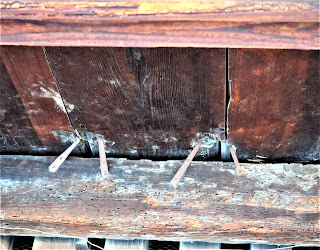




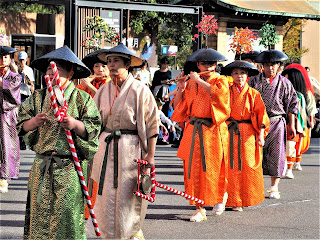


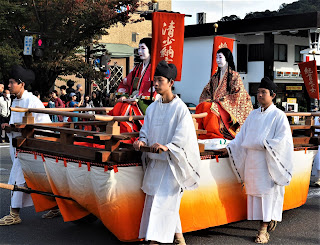













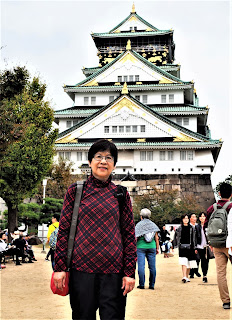

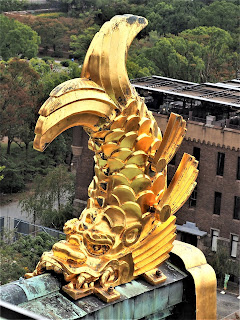






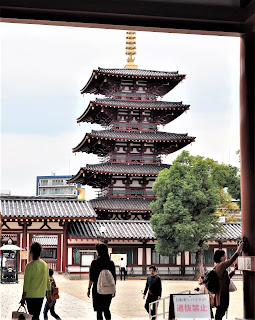









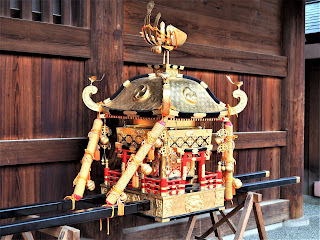






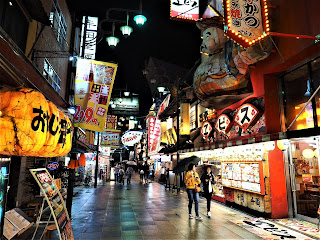







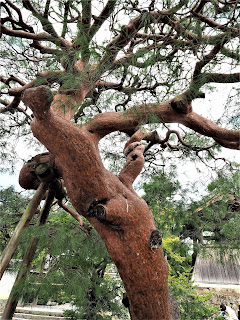
No comments:
Post a Comment